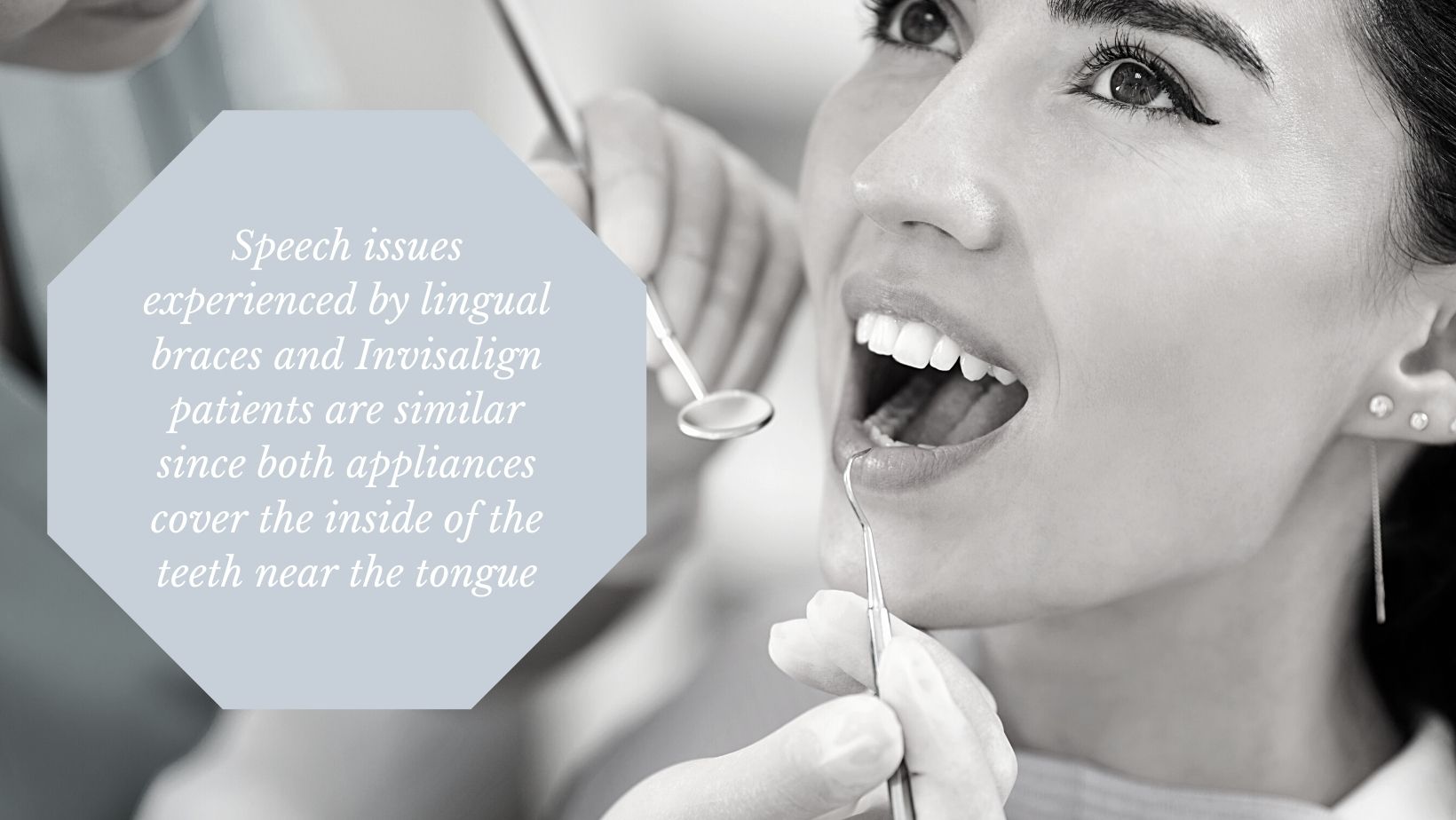There are plenty of options for correcting cosmetic dental issues like crowded or crooked teeth. Braces are one of the most common tools used by orthodontists. Braces can be placed on the front of the patient’s teeth, or, in the case of lingual braces, hidden behind the teeth. Another less visible alternative uses plastic trays to straighten teeth. The most common brand of this product is Invisalign.
There are pros and cons to each approach, including effectiveness, visibility, and, of course, how it affects the patient’s speech. While it’s natural for new orthodontic treatments to cause some minor speech issues at first, the effect is almost always temporary.
Speech Issues are Temporary
For many people, how braces will affect speech is as important as how they will look. Perhaps the patient has an important event like the first day of school, a wedding, or a job interview coming up. Maybe speaking clearly is required as part of the person’s job as an air traffic controller, help desk technician, or teacher.
When a person talks, the tongue touches the back of the teeth to make certain sounds. Because lingual braces come into contact with the patient’s tongue, they may cause a lisp or difficulty pronouncing some words. For instance, words with “s,” “sh,” and “th” sounds might be challenging at first.
However, while lingual braces may take some getting used to, speech changes are usually temporary. As the patient gets used to the braces over the first several days, speech returns to normal.

Comparing Lingual Braces vs. Traditional Braces
Orthodontic braces help straighten teeth with brackets that are glued to the teeth and wires that are threaded through slots in the brackets and then secured with rubber bands. Some patients may also have metal bands placed around their back teeth. Brackets can be either metal (stainless steel) or tooth-colored ceramic.
With traditional braces, brackets are placed on the front surface of the teeth. Lingual braces are glued to the back side. In addition to this main difference, there are several other considerations that patients often weigh when choosing between traditional and lingual braces, as shown in the chart below.
| Lingual Braces | Traditional Braces | |
| Appearance | Placed behind the teeth – practically invisible to others | Cemented to the front tooth surface – noticeable to others |
| Effectiveness | Can fix most problems; may not be suitable for severe cases or patients with small teeth | Can be used to treat most problems from minor to severe |
| Speech issues | May cause a lisp but the effect is temporary | Usually do not alter the patient’s speech |
| Comfort | Can cause discomfort where the tongue touches the brackets | Can cause temporary discomfort on the inside of the cheeks and lips |
| Cost | More expensive | Less expensive |
Appearance
Whether an image-conscious teenager, an aspiring actor, or a working professional, it’s common for a patient to want to hide dental work in progress. Even when ceramic brackets are used, traditional braces are noticeable.
Lingual braces, placed behind the teeth, are practically invisible to other people. They can only be seen at certain angles and when the patient’s mouth is open wide.
Effectiveness
Braces can be used to fix minor to severe orthodontic problems, and lingual braces can fix most of the same issues that traditional braces can. Because of their location behind the teeth, lingual braces may not work for severe overbites, but they work well for crookedness, crowding, and gaps.
In addition, lingual braces may not be recommended for children or adults with small teeth. Since the back surface of teeth is smaller than the front, orthodontists may have trouble fitting brackets, especially when teeth are very crooked.
Speech issues
Traditional braces don’t usually alter the patient’s speech. Because lingual braces affect how the tongue touches the inside of the teeth, the patient may lisp or have trouble saying certain words as they adjust. However, this is usually temporary. After a short time, the patient will get used to the lingual braces and speak normally.
Comfort

Both traditional and lingual braces cause some mild pain as teeth are slowly moved into position. Discomfort usually resolves a day or two after each adjustment by the orthodontist.
Brackets and wires may also rub against the soft tissues of the mouth. With traditional braces, patients can experience discomfort on the inside of their cheeks and lips. With lingual braces, patients may have discomfort where the tongue touches the brackets. This soft tissue pain is usually temporary and resolves after the wearer gets used to the braces.
Though they affect different areas of the mouth, the temporary discomfort felt with traditional braces and lingual braces is similar.
Cost
Lingual braces are more expensive because they are trickier to place and maintain than traditional braces. For this reason, lingual braces are not offered by all orthodontists, and this can also affect the price.
Comparing Lingual Braces vs. Invisalign
Another option for patients looking for a less visible option is Invisalign.
Invisalign uses a series of plastic aligner trays to straighten teeth over time. Because Invisalign uses smooth, clear plastic instead of brackets, it is much less noticeable than traditional metal or ceramic braces. Some other considerations are compared below.
| Lingual Braces | Invisalign | |
| Appearance | The least visible option | Plastic trays are noticeable up close |
| Effectiveness | Can correct more severe issues | Not effective for severe cases |
| Speech issues | Can cause a temporary lisp or difficulty speaking | Can cause temporary speech issues; trays can be removed |
| Comfort | May cause discomfort on the tongue | Smooth plastic does not hurt soft tissue |
| Cost | More expensive | Less expensive |
Appearance
Though Invisalign is less noticeable than traditional braces, other people can still see the plastic trays covering the patient’s teeth. Lingual braces are the least noticeable option when compared to traditional braces and Invisalign.
Effectiveness
Invisalign tends to be a faster treatment than lingual braces. However, Invisalign is only appropriate for mild to moderate issues – for extremely crooked teeth or significant alignment issues, braces are the way to go.
Since the trays are removable, Invisalign is less permanent than braces. This can affect how well the treatment works if the patient does not wear the trays the required 20 to 22 hours each day. Because lingual braces are not removable, they are always working.
Speech issues
Speech issues experienced by lingual braces and Invisalign patients are similar since both appliances cover the inside of the teeth near the tongue. Any lisp or difficulty talking is usually temporary.
Of course, since Invisalign trays are removable, patients have the option to take them out for a short time if worried about speech issues at an important event. However, long periods of not wearing them can reduce the effectiveness of the treatment.
Comfort
Patients usually experience similar mild tooth pain when braces are adjusted and when a new set of Invisalign trays is introduced. However, because Invisalign trays are made of smooth plastic, they do not cause the friction and pain on the tongue that may occur with lingual braces.
Cost
Lingual braces are typically more expensive than Invisalign treatments.
Overcoming Speech Issues with Lingual Braces
Though lingual braces cost more than the alternatives, they are effective and provide the most invisible solution for patients who want to hide their orthodontic treatment. And, like other options, any speech issues experienced with lingual braces are temporary.
Once a patient chooses to move forward with lingual braces, there are a few strategies that can help with overcoming any speech changes. The most important advice is to practice! The more the patient talks, the faster the mouth and tongue will get used to the braces. Patients can try reading aloud, singing, or even running speech drills used by actors (many can be found online for free). It may be helpful to practice in front of a mirror to observe how the mouth moves when saying tricky words. After a short amount of time, speech will return to normal.
Since not all orthodontists offer lingual braces, patients can use our online search tool to find one in their area.


